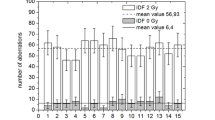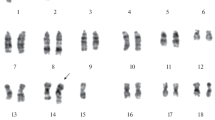Abstract
By means of combined experiments of X-irradiation and 3H-thymidine labeling of the chromosomes which are in the phase of synthesis, and the subsequent analysis at metaphase on the autoradiographs of the chromosomal damage induced during interphase, it was shown that in somatic cells from a quasi-diploid Chinese hamster line cultured in vitro the chromosomes change their response to radiation from single (chromosome type aberrations) to double (chromatid type aberrations) in late G1. These results are interpreted to indicate that the chromosome splits into two chromatids in G1, before DNA replication. — By extending the observations at the second metaphase after irradiation, it was also seen that cells irradiated while in G2 or late S when they reach the second post-irradiation mitosis still exhibit, beside chromosome type aberrations, many chromatid exchanges, some of which are labeled. Two hypotheses are suggested to account for this unexpected reappearance of chromatid aberrations at the second post-irradiation division. The first hypothesis is that they arise from half-chromatid aberrations. The second hypothesis, which derives from a new interpretation of the mechanisms of production of chromosome aberrations recently forwarded by Evans, is that they arise from gaps or achromatic lesions which undergo, as the cells go through the next cycle, a two-step repair process culminating in the production of aberrations.
Similar content being viewed by others
References
Alfert, M.: Quantitative cytochemical studies on patterns of nuclear growth. In: Symposium on the Fine Structure of Cells, p. 157–163. Groningen: Noordhoff 1955.
Bloch, D. P., and C. G. Godman: A microphotometric study of the syntheses of desoxyribonucleic acid and nuclear histone. J. biophys. biochem. Cytol. 1, 17–28 (1955).
Evans, H. J.: Chromosome aberrations induced by ionizing radiations. Int. Rev. Cytol. 13, 221–321 (1962); - Uptake of 3H-thymidine and patterns of DNA replication in nuclei and chromosomes of Vicia faba. Exp. Cell Res. 35, 381–393 (1964);- Repair and recovery from chromosome damage induced by fractionated X-ray exposures. In: Radiation research (G. Silini ed.). Amsterdam: North Holland Publ. Co. 1967.
—, and J. R. K. Savage: The relation between DNA synthesis and chromosome structure as resolved by X-ray damage. J. Cell Biol. 18, 525–540 (1963).
Gilbert, C. W., S. Muldal, L. G. Lajtha, and J. Rowley: Time sequence of human chromosome duplication. Nature (Lond.) 195, 869–873 (1962).
Heddle, J. A., and J. E. Trosko: Is the transition from chromosome to chromatid aberrations the result of the formation of single-stranded DNA? Exp. Cell Res. 42, 171–177 (1966).
Hsu, T. C., W. C. Dewey, and R. M. Humphrey: Radiosensitivity of cells of Chinese hamster in vitro in relation to the cell cycle. Exp. Cell Res. 27, 441–452 (1962).
—, and M. T. Zenzes: Mammalian chromosomes in vitro. XVII. Idiogram of the Chinese hamster. J. nat. Cancer Inst. 32, 857–869 (1964).
LaCour, L. F., and A. Rutishauser: X-ray breakage experiments with endosperm. I. Sub-chromatid breakage. Chromosoma (Berl.) 6, 696–709 (1954).
Lima-de-Faria, A.: Differential uptake of tritiated thymidine into hetero- and euchromatin in Melanoplus and Secale. J. biophys. biochem. Cytol. 6, 457–466 (1959); - DNA replication in human chromosomes. A review. In: Mammalian cytogenetics and related problems in radiobiology (C. Pavan et al.), (eds.), p. 31–37. London: Pergamon Press 1964.
—, J. Reitalu, and S. Bergman: The pattern of DNA synthesis in the chromosomes of man. Hereditas (Lund) 47, 695–704 (1961).
— and M. A. O'sullivan: Replication of autosomal heterochromatin in man. Chromosoma (Berl.) 16, 152–161 (1965).
Mattingly, Sister A.: Nuclear protein synthesis in Vicia faba. Exp. Cell Res. 29, 314–326 (1963).
McLeish, J.: Comparative microphotometric studies of DNA and arginine in plant nuclei. Chromosoma (Berl.) 10, 686–710 (1959).
Mitra, S.: Effects of X-rays on chromosomes of Lilium longiflorum during meiosis. Genetics 43, 771–789 (1958).
Monesi, V.: Autoradiographic study of DNA synthesis and the cell cycle in spermatogonia and spermatocytes of mouse testis using tritiated thymidine. J. Cell Biol. 14, 1–18 (1962) - Synthetic activities during spermatogenesis in the mouse. RNA and protein. Exp. Cell Res. 39, 197–224 (1965).
—, and M. Crippa: Ribonucleic acid transfer from nucleus to cytoplasm during interphase and mitosis in mouse somatic cells cultured in vitro. Z. Zellforsch. 62, 807–821 (1964); - Osservazioni preliminari sullo stadio della scissione dei cromosomi durante il ciclo cellulare. Boll. Zool. 31, 1267–1270 (1964) (Abstr.).
Moorhead, P. S., and V. Defendi: Asynchrony of DNA synthesis in chromosomes of human diploid cells. J. Cell Biol. 16, 202–209 (1963).
Moses, M. J., and J. H. Taylor: Deoxypentose nucleic acid synthesis during microgametogenesis in Tradescantia. Exp. Cell Res. 9, 474–488 (1955).
Ohno, S., and C. Weiler: Relationship between large Y-chromosome and sideby-side pairing of the XY-bivalent observed in the Chinese hamster, Cricetulus griseus. Chromosoma (Berl.) 13, 106–110 (1962).
Painter, R. B., and R. M. Drew: Studies on deoxyribonucleic acid metabolism in human cancer cell cultures (HeLa). I. The temporal relationships of deoxyribonucleic acid synthesis to mitosis and turnover time. Lab. Invest. 8, 278–285 (1959).
Puck, T. T., P. I. Marcus, and S. J. Cieciura: Clonal growth of mammalian cells in vitro. Growth characteristics of colonies from single HeLa cells with and without a “feeder” layer. J. exp. Med. 103, 273–284 (1956).
Revell, S. H.: The accurate estimation of chromatid exchanges and its relevance to a new interpretation of chromatid aberrations induced by ionizing radiations. Proc. roy. Soc. Lond. B, 150, 563–589 (1959).
Sax, K., and E. D. King: An X-ray analysis of chromosome duplication. Proc. nat. Acad. Sci. (Wash.) 41, 150–155 (1955).
Setlow, R. B., and W. L. Carrier: The disappearance of thymine dimers from DNA: an error-correcting mechanism. Proc. nat. Acad. Sci. (Wash.) 51, 226–231 (1964).
Taylor, J. H.: Autoradiographic detection of incorporation of P32 into chromosomes during meiosis and mitosis. Exp. Cell Res. 4, 164–173 (1953); - The mode of chromosome duplication in Crepis capillaris. Exp. Cell Res. 15, 350–357 (1958);- Asynchronous duplication of chromosomes in cultured cells of Chinese hamster. J. biophys. biochem. Cytol. 7, 455–464 (1960).
Taylor, J. H., P. S. Woods, and W. L. Hughes: The organization and duplication of chromosomes as revealed by autoradiographic studies using tritium-labeled thymidine. Proc. nat. Acad. Sci. (Wash.) 43, 122–128 (1957).
Thoday, J. M.: Radiation-induced chromosome breakage, deoxyribonucleic acid synthesis and the mitotic cycle in root-meristem cells of Vicia faba. New Phytologist 53, 511–516 (1954).
Wimber, D. E.: Asynchronous replication of deoxyribonucleic acid in root tip chromosomes of Tradescantia paludosa. Exp. Cell Res. 23, 402–407 (1961).
Wolff, S.: Interpretation of induced chromosome breakage and rejoining. Radiat. Res., Suppl. 1, 453–462 (1959); - Radiation studies on the nature of chromosome breakage. Amer. Naturalist 44, 85–93 (1960).
—, and H. E. Luippold: Chromosome splitting as revealed by combined X-ray and labelling experiments. Exp. Cell Res. 34, 548–556 (1964).
Author information
Authors and Affiliations
Additional information
This work was supported in part by grant No. RH-00304 from the Division of Radiological Health, Bureau of State Services, Public Health Service, U.S.A.
Rights and permissions
About this article
Cite this article
Monesi, V., Crippa, M. & Zito-Bignami, R. The stage of chromosome duplication in the cell cycle as revealed by X-ray breakage and 3H-thymidine labeling. Chromosoma 21, 369–386 (1967). https://doi.org/10.1007/BF00336948
Received:
Issue Date:
DOI: https://doi.org/10.1007/BF00336948




